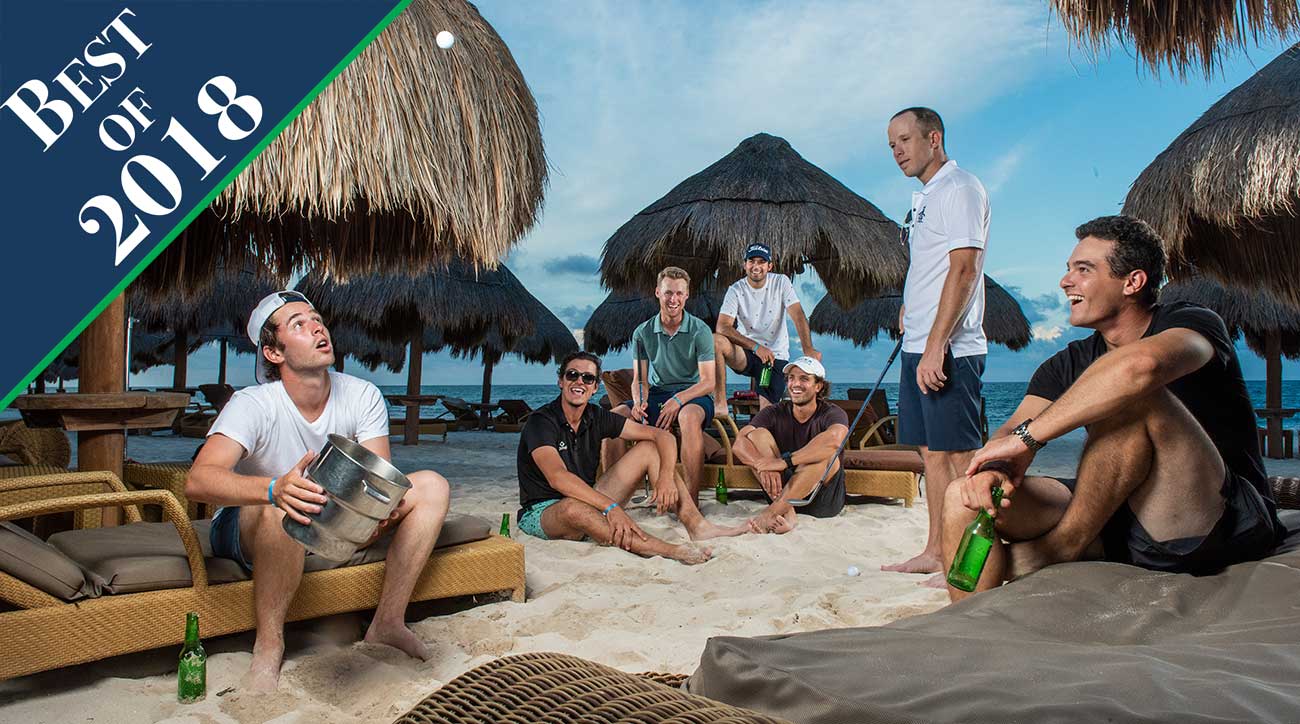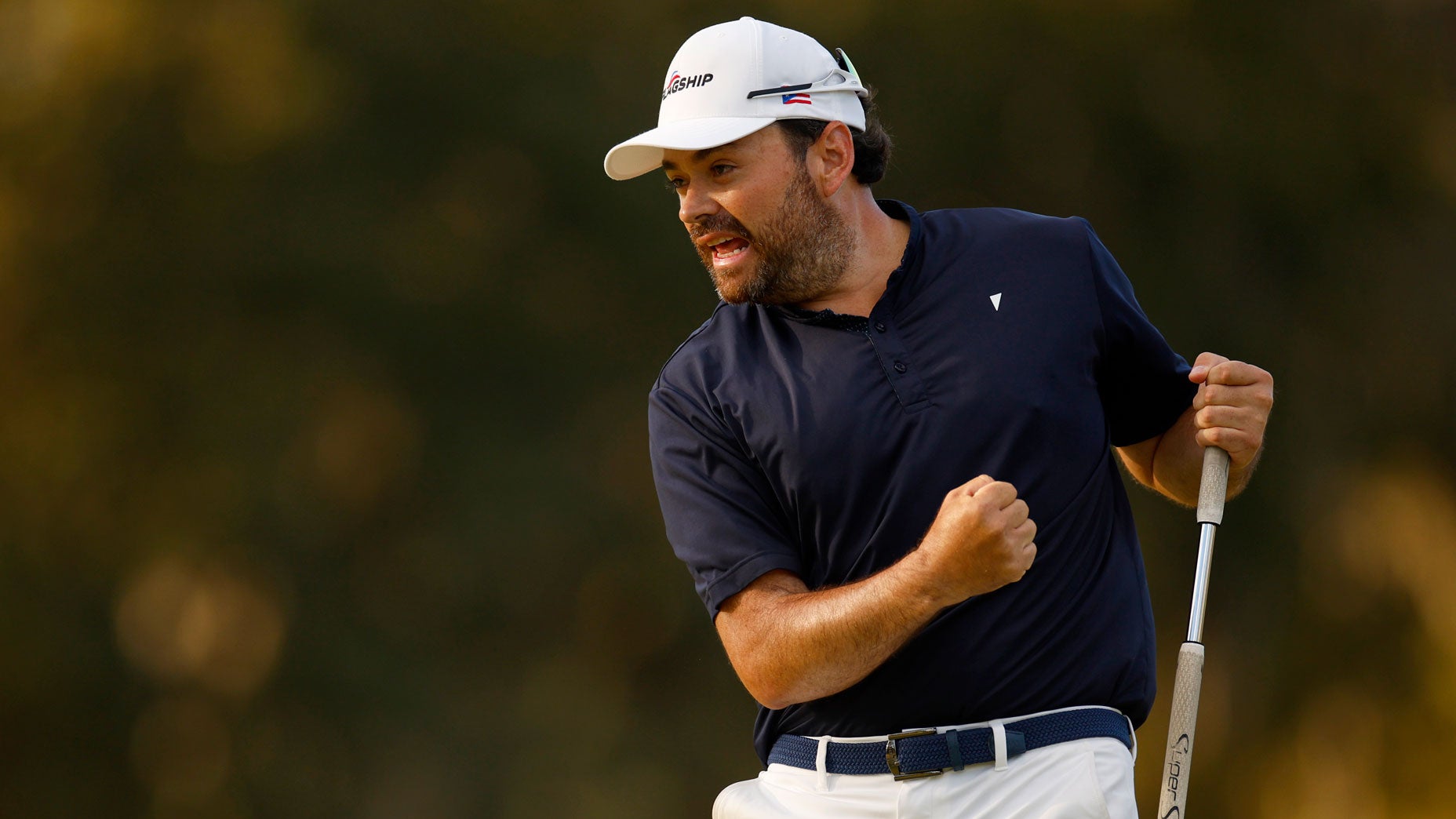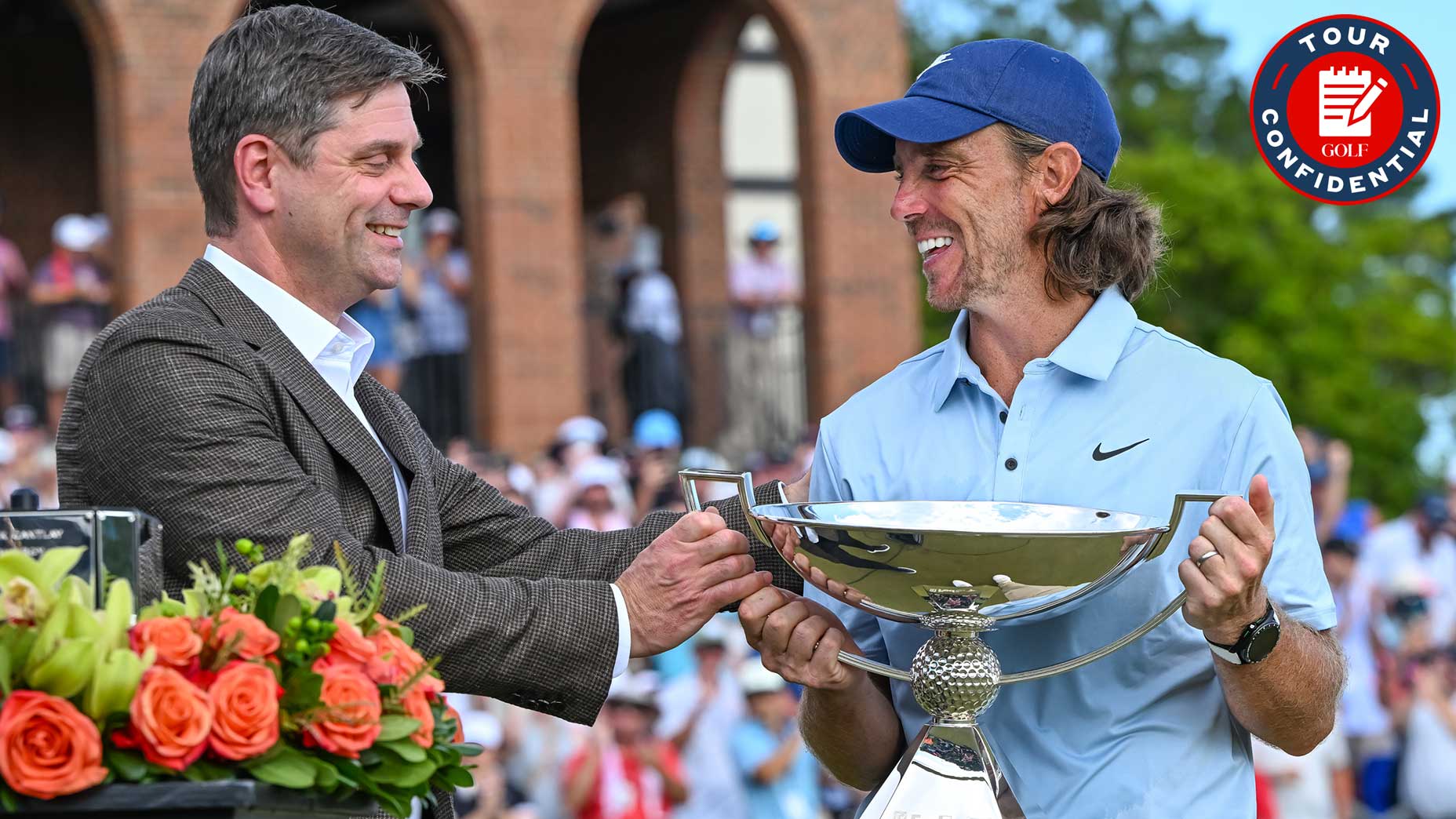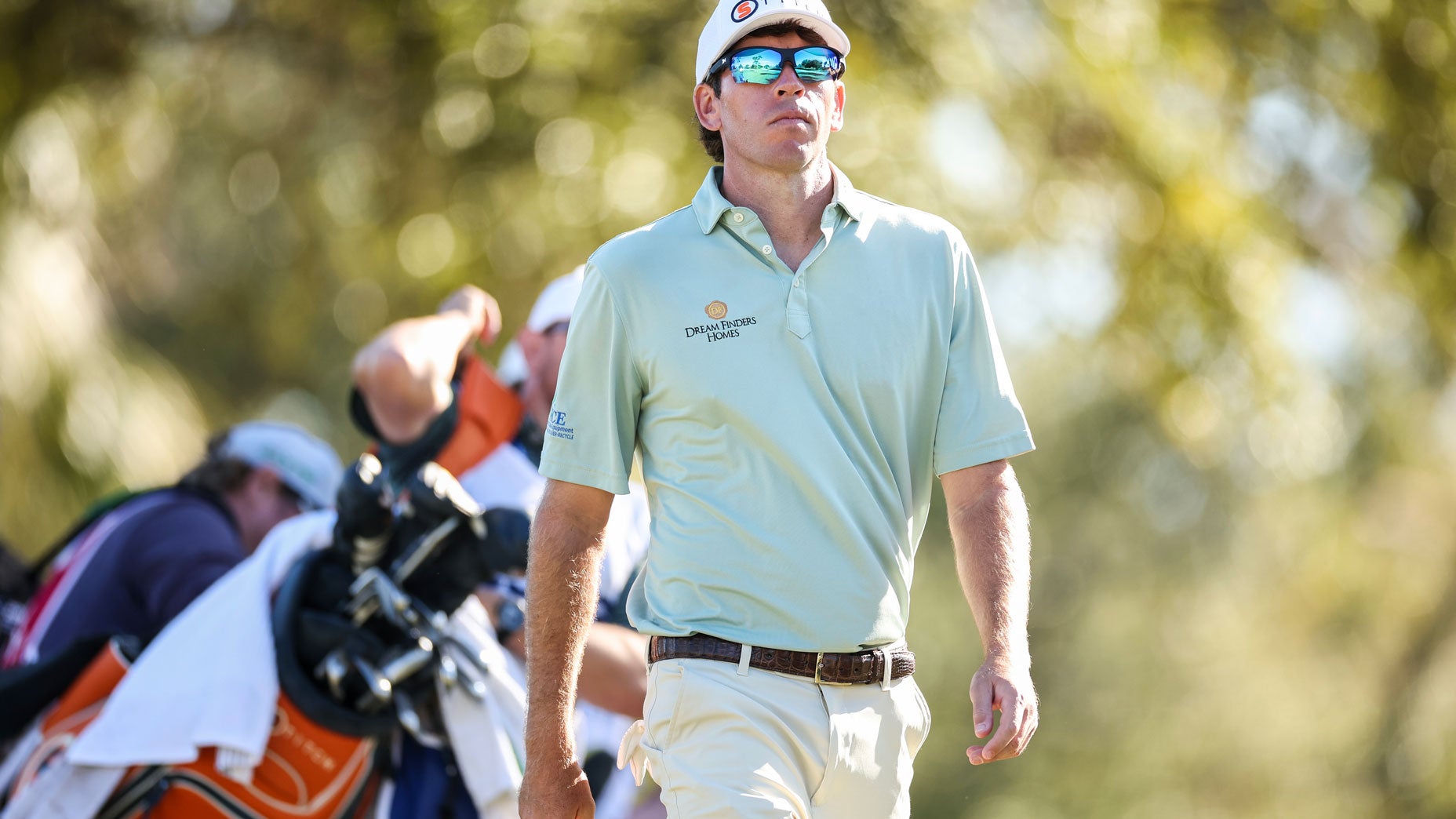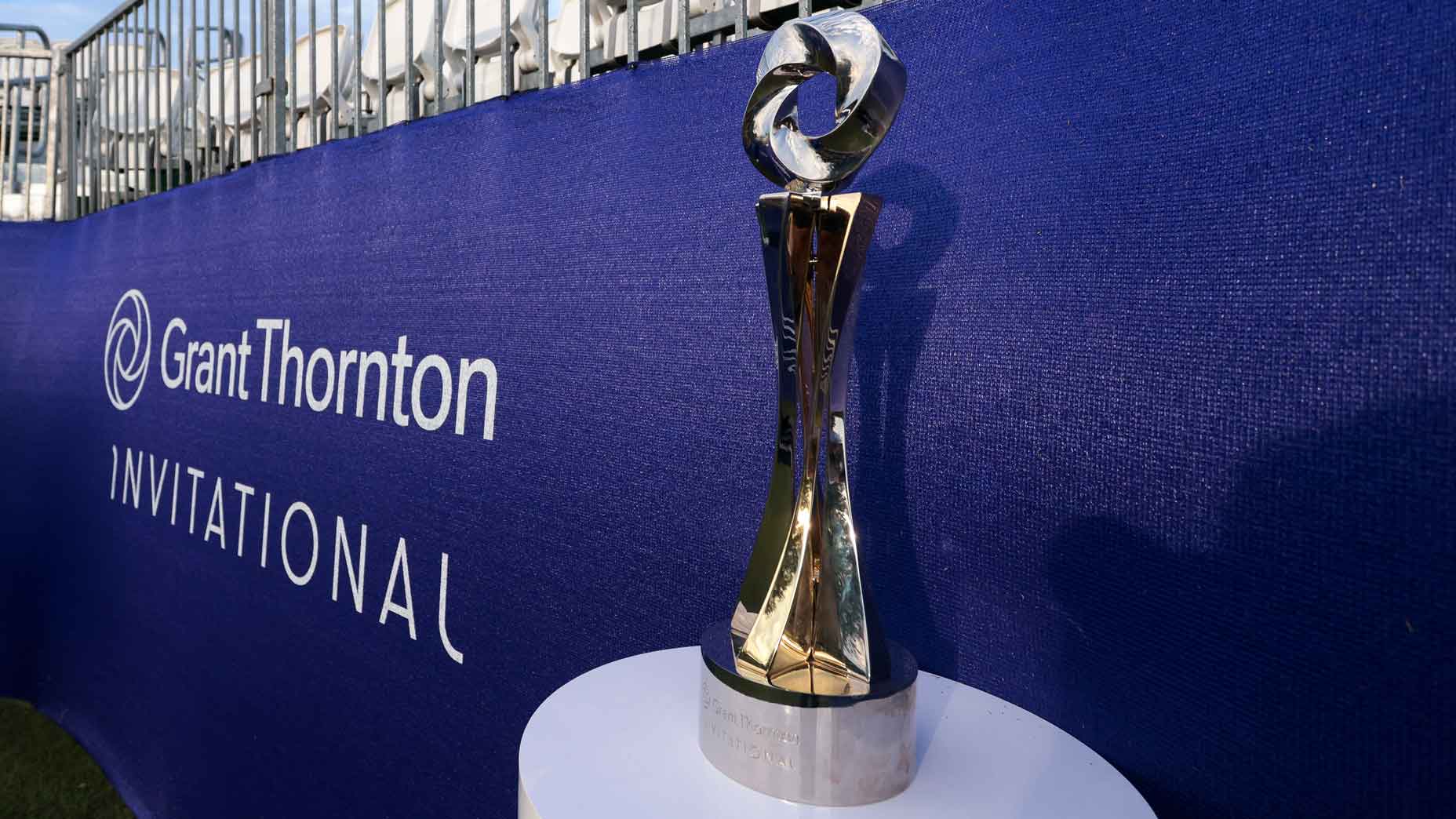To truly understand the PGA Tour Latinoamérica (LAT), it is necessary to experience one of the ornate travel days that define this far-flung circuit. Speeding to the Montego Bay airport, Michael Buttacovali was squished into a minivan along with a family of four. The trophy he had won with a closing 62 at the Jamaica Classic was at his feet, and a baby stroller kept toppling over and smashing into his shoulder, although Buttacovali barely flinched. “If you’re gonna survive on this tour, you have to get comfortable being uncomfortable,” he said.
At 5 a.m., the airport began filling up with players in the unofficial travel-day uniform of shorts, graphic T-shirts, hats with the logo of a hometown sports team, and fashionable sneakers, although Harry Higgs, a 6’2”, 235 lb. Dallas resident who is a bit of a dandy, was flashing tassel loafers. Near the departure gate, the Latin American players clustered around tables, daintily sipping espresso. The Yanks were slouched in the airport chairs, trading gossip about Lee Westwood’s love life and LeBron James’s free agency. Costa Rica is southwest of Jamaica, but since there are no direct flights, this motley crew was flying north to connect through Miami. (It could be worse; the following week, to get from Costa Rica to the Dominican Republic, a cash-strapped rookie named Mike Balcar would first fly to Houston and then Toronto, an absurd itinerary cooked up by Orbitz to save him a few hundred bucks.) As the players filed down the plane’s aisle, they exchanged elaborate handshakes with their seated comrades, and the few who had snagged extra legroom were hailed for their “exit row swag.”
It was a convivial atmosphere, although those with window seats watched anxiously as the luggage was being loaded. The weekly game of “golf bag roulette” had begun; these guys don’t travel light, and the small planes they overwhelm are habitually overweight, leading to many golf bags getting offloaded at the last minute. “There are a lot of theories about which bags get taken off, and why,” said Hans Reimers, a 27-year-old Oregon native playing his second season on tour. “Some guys think it’s best to check in first, to get the bag on the plane as quickly as possible. Some think it’s better to wait ’til the last minute so your bag sneaks on at the end. It’s probably just random, which makes it more frustrating.”
The journey to Miami was uneventful, but as the players gathered around gate D23, an announcement went up that the flight to Costa Rica was oversold and a $500 travel voucher would be given to any passenger who gave up their seat and took a flight the following morning. A buzz went through the gate area. Money is tight for virtually every competitor on the LAT. A number universally cited to fulfill the 18-tournament, 15-country schedule is $40,000. The purse for each event is a mere $175,000, and in 2017 the leading money winner, Jose de Jesus Rodrigues, of Mexico, cleared $119,oo1, with only 22 players earning $40,000 or more…before taxes. Thus the tour is full of tales of maxed-out credit cards and shady financial backers who have exploited desperate young dreamers.
Still, spending 24 hours in Miami would mean giving up a precious practice round in Costa Rica and needed time to acclimate to the scorching temperatures. There were no takers for the $500. A few minutes later, the value of the voucher was raised to $700. Whistles and cheering ensued. A bunch of the LAT’s fellow travelers, suddenly tempted, started pecking at their phones, checking on the cancellation policy of their hotels and rental cars in Costa Rica. Still, no one made a move. Ten minutes went by and then another announcement: $1,000. A gent with no affiliation to the tour ambled toward the counter to take the money, but he was no match for the desperation of Jonathan DiIanni, who sprinted by him to claim the voucher. The entire gate area exploded in whooping and hollering. With a beatific smile, DiIanni announced that in addition to the grand, he was getting a free hotel room and a fistful of meal vouchers. “It’s like hitting the lottery,” he said. Later that week, DiIanni, a 24-year-old North Carolinian with a deep love of country music, would shoot 75-70 to miss the cut by six strokes.

The Costa Rica Classic was won by Tyson Alexander, 30, the son of Buddy Alexander, the 1986 U.S. Amateur champ and longtime coach at Florida. Tyson won Hooters Tour events in 2012 and 2014, but his LAT breakthrough propelled him to the top of the money list ($58,738) as the tour shut down for the steamy summer months; the second-half of the schedule runs from late August through early December. In victory, he sounded like a weary veteran who knows that minor league golf is a war of attrition. “I’ve just been playing pretty solid and staying out of my own way,” said Alexander, whose grandfather Skip was a three-time winner on the PGA Tour in the years following WWII. “Obviously, the win will jump me up on the money list, but we have a lot of golf to play, a lot of season to go.”
His caddie, Saul Mejia, was far more ecstatic, posting dozens of photos on his Facebook page. Mejia is from Honduras and had driven three days to get to Costa Rica, sleeping in his car along the way. On the LAT, everyone wants to be somewhere else. “My dream is to be a caddie on the PGA Tour, and you have to start somewhere,” Mejia said through an interpreter. Then he offered a thought that could serve as the motto for the entire tour: “It was a long, tough journey, but it was worth it.”
* * * * *
Professional golf is as stratified as professional baseball. The PGA Tour is the big leagues, while the Web.com is the equivalent of triple-A minor leagues. The LAT is double-A ball, on par with the PGA Tour Canada (aka the Mackenzie Tour) and the PGA Tour China. All three of these developmental circuits are under the umbrella of the big tour and offer the same avenues for advancement: The top five finishers on the respective money lists earn playing privileges on the Web.com Tour, while those finishing sixth through 50th are given special considerations for the Web Q School. For players just starting out or just hanging on, China is considered the easiest place to play your way to the next level, due to a shallower pool of talent. But few players from the Americas make the journey. The flights are longer, the culture more foreign, unsettling stories about the food circulate, and other subtle considerations weigh heavily. “I’ve thought about going,” says Michael Davan, a 29-year-old Illinois native, “but with the time change it would be hard to keep in touch with my wife. When I’d be awake she’d be asleep and when she was awake I’d be sleeping, and that would be really challenging for us.”
Canada is much easier to navigate, but many of the courses are short and tight and don’t fit the freewheeling style of play favored by today’s youth. The taxes are onerous, and, let’s face it, Saskatoon is not nearly as sexy as Buenos Aires or Rio de Janeiro. “No offense to Canada,” says Samuel Saunders, a New Mexico native who played the Mackenzie Tour in 2015, “but there are soooo many beautiful women in Latin America.”

There are many other reasons why the LAT is golf’s ultimate adventure: famous surf breaks in Costa Rica and Nicaragua, giant tarpon fishing in Honduras, arm wrestling while lying across the equator in Ecuador, hitting golf shots in the shadow of Volcan de Fuego in Guatemala while it erupts ash. The exotic venues marry the Golf Channel with the Discovery Channel, whether it’s howler monkeys in the trees in Costa Rica, dog-sized lizards prowling the courses in Mexico, or capybara roaming the Olympic course in Rio. Rafa Becker, a Brazilian who played his college golf at Wichita State, was stung by a scorpion in his bed in Nicaragua (his roommate Rodrigo Lee drove all night on dirt roads to get him to a primitive medical clinic) while Reimers enlisted four players to exterminate with flip-flops a huge, hairy tarantula in his room in Honduras.
The playing fields are astonishingly diverse: You can get sprayed by waves in the D.R. and hit the ball for miles in Quito, Ecuador, which is 9,300 feet above sea level. Carved out of verdant jungle, Jamaica’s Cinnamon Hill looks like a movie set, and in fact a waterfall visible on the back nine made a cameo in the 007 flick Live and Let Die. The tour visits two Alister Mackenzie masterworks: the Jockey Club in Buenos Aires and the Golf Club of Uruguay in Montevideo.
When it comes to the prestige of the tournaments, the LAT easily outshines the events on the other developmental circuits. The Mackenzie Tour only gets three spots in the Canadian Open, and the PGA Tour China no entrée to the WGC-HSBC Champions in Shanghai, but the LAT hosts numerous national championships. Notable among them are the Argentine Open, founded in 1905, at which Angel Cabrera and Eduardo Romero are regulars and past champs include Roberto De Vincenzo, Jimmy Demaret and Tom Weiskopf; and the Mexico Open, which dates to 1948 and has a roll call of winners that includes Lee Trevino, Billy Casper, Tony Lema, Ben Crenshaw and Bobby Locke.

Whether it’s Argentina, Mexico or any other stop on the LAT, the players are paid out in American dollars. But there are few other constants, and unusual sights and sounds abound. In Quito, range balls are hand-picked by fearless kids scampering on foot even as players keep hitting shots. The caddies often speak a different language or dialect from the players, or, as in Jamaica, with a baffling patois. (Waist-length dreadlocks are also a unique sight inside the ropes.) Players on the LAT rave about the different cuisines, but some carry baby wipes in their golf bags in case of gastrointestinal emergencies. (One player, who begged for anonymity, lost control of his bowels in the middle of a round and was forced to waddle through a couple of holes before finding a port-a-potty in which to dispose of his soiled underwear. He went commando for the rest of the round…in white pants. Truly a profile in courage.) Surviving the heat and humidity can require localized solutions. In Jamaica, bartenders at the clubhouse wielded machetes to cut off the tops of coconuts, and after straws were inserted, many players wandered around sipping the coconut water, an excellent source of electrolytes.
Weird things just sort of happen on the LAT, like the cancellation of the final round of the 2017 Peru Open because a national census mandated that every resident remain indoors throughout that particular Sunday. Logistical riddles demand flexibility and creative thinking: When the taxi prices in Montego Bay were too high, some players hitchhiked to and from the course along the A1 roadway. At the conclusion of this year’s event in Tijuana, a bunch of guys rolled their suitcases and clubs across the border and caught Ubers in a Burger King parking lot.
As the cheering in the Miami airport suggests, the players on the LAT bond deeply through all the hardship and wonderment. “We all look out for each other,” says Nick Palladino, 25, who played Div. III golf at Rochester. “We’re all a long way from home, traveling alone, so these guys become like family.” They share hotel rooms and rental cars, boozy, gossipy dinners, and a wide variety of adventures. Two days before the start of the Costa Rica Classic, a local surf guide named Robbie Twine loaded up his truck with boards, a pack of dogs (including Sugar, who has a prosthetic leg) and four LAT players: Brad Gehl, Santiago Bauni, Rafa Becker and Sandro Piaget (an American, Argentinian, and two Brazilians, respectively). They spent the day riding the perfect waves at Playa Avellanas, where the crystalline waters were dotted with at least a hundred surfers, including, it must be noted, a number of gorgeous women in minimalist swimsuits. “The locals are really friendly, it’s a really good scene here,” said Gehl, an Indiana native who, thanks to the LAT, has also shredded waves in Nicaragua, Brazil and Peru. With the warm sea lapping at his ankles, he said, “The travel can be tough, but you need to embrace the opportunities like this. For sure, golf is why we’re here, and we all take it very seriously, but if you get out and enjoy the world, I think it helps your game, too. This is the perfect kind of meditation away from golf that gets me in a good state of mind.”

No wonder Nick Biesecker, an agent at Blue Giraffe management, has steered a number of young players to the LAT. “The fact is, golf is more global than ever,” says Biesecker. “Learning to play in different altitudes, climates and on different grasses makes for a better, more rounded player. Players who come up on other tours often seem lost the first time they have to travel internationally.”
Austin Smotherman, 24, also sees the value in launching his career on the LAT. The soft-spoken Dallas resident won this year’s Mexico Open for his first professional victory. “There are so many challenges,” says Smotherman, who is married and conducts himself with the smooth professionalism of a player who is going places. “So many things go wrong, and you often get pushed out of your comfort zone. The bottom line is, if you can learn to thrive out here, every other tour in the world is going to feel easy.”
* * * * *
Over the first-half of the 2018 season, seven of the top 10 on the money list were Americans, which begs a question: Should the LAT be more Latin American? Structurally, the tour has been set up to encourage homegrown talent. Of the four annual Q Schools, three are held in Latin America—usually in Mexico, Colombia and Argentina. (The fourth is always in Florida.) Each LAT tournament can use up to 24 sponsor’s exemptions, which traditionally go to up-and-coming young players from the host country. The Dev Series is a feeder for the LAT, with 15 to 20 annual mini-tour events played in various Latin American markets. The top 15 finishers on the Dev Series money list earn a spot in the LAT’s season-ending event, where a good showing can secure playing privileges on the LAT for the following season. The tournament purses are so small that virtually no Americans play on the Dev Series.
But tournament golf is a meritocracy, and ultimately the LAT will be defined by the players shooting the best scores. With positive word-of-mouth drawing more Americans each year, the demographics of the tour have evolved rapidly since its inception in 2012, when it cannibalized the Tour de las Americas.
“That first year it was just a bunch of Latin guys,” says Jose Andres Miranda, who competed in the early years of the LAT as one of the best teenaged golfers in Ecuador. “Now it’s 70 percent American.” Is that a good thing or a bad thing? “There is always a lot of discussion about that,” says Miranda, who played his college golf at Lynn University in Florida. “In my view, if the U.S. players go through Q School, it is fair. They’ve earned it. But maybe not everyone agrees with me and they feel more spots should be set aside for Latin players.”
The LAT is still fighting to attract the best young talent across Latin America, where the golf scene can be provincial. Alfredo Ruiz is a 23-year-old rookie from Mexico City, and as he cobbles together his schedule he is often torn between playing at home, where he feels he is always one of the better players in the field, and rolling the dice at the LAT’s distant events. “The Mexico Tour is paying good money, probably two-thirds of the LAT purses, and I can stay for free with family and drive my own car,” says Ruiz. “It was so expensive to fly to Jamaica I just stayed home and played a tournament there. That made more sense.”

Andres Echavarria, a Colombian who played college golf at the University of Florida, thinks cultural differences explain the influx of Yanks on the LAT. “The American guys have a longer-term view,” says Echavarria, 30, whose younger brother Nicolas is also playing the LAT. “They see this tour as an investment in their future, so they are willing to lose money, even for two or three years in a row, if that will help them eventually. Latin Americans don’t think that way. I know five Colombians, ten Argentinians, three or four Brazilians and a half dozen Mexicans who are better than most of the Americans here, but they refuse to lose money to play golf, so they won’t play this tour.”
Even so, the LAT is inexorably reshaping the golf scene in Latin America. Says Miranda, “Ecuador is a small country, and there have been few golfers. But having [the Quito Open] every year has changed things. More young players are coming to the game, and everybody is working harder because they see what it takes. The LAT has made the path clear. Sure, it’s difficult to get on tour, and it’s difficult to stay here, but the way forward is clear. It is up to the players—in Ecuador and all of Latin America—to follow the path.”
* * * * *
There are eight full-time PGA Tour staffers dedicated to running the LAT and another half-dozen contractors who are more or less full-time. Despite the logistical challenges, the tour leadership takes pride in the product it presents. Says LAT president Jack Warfield, “I always say that outside the ropes every tournament is drastically different, but inside the ropes it is very consistent.”
While the tour has walkie-talkie-toting rules officials and other accoutrements of big-time golf, things do look a bit different inside the ropes, beginning with the players’ exotic plumage. Danny List, a 19-year-old Aussie, wears diamond studs in each ear of a size rarely seen outside of hip-hop music videos. The hair on the LAT is next level: spiked, dyed, shaved, frosted, shoulder-length and in perfectly formed man-buns. A good number of players get free or discounted clothing to wear, but in the absence of ironclad endorsement deals, they are free to express themselves sartorially. Ross Beal, a 31-year-old Orlando resident, played the second round in Jamaica in a red visor with familiar white lettering, though this one said MAKE THE GOLF BALL CURVE AGAIN. On the LAT, even the golf bags look different—many are the lightweight carry kind, with big leather Tour bags being a low-key status symbol.
LAT events are also notable for what’s missing: on-course scoreboards. The players can occasionally glean information about where they stand from roving tour officials, but live scoring is updated only every three holes, so final rounds pulsate with the added tension of competitors never really knowing where they stand. “You can’t ever take your foot off the gas,” says Will Collins, a Southern boy who travels with his own fly-fishing rod, “because if you do you might get passed and not even know it.”
That mentality helps produce fireworks and hardened players: At the final stage of the 2017 Web.com Q School, 17 of the top 45 golfers were LAT grads. At the rain-shortened Jamaica Classic, Buttacavoli, 30, came to the final hole not knowing exactly where he stood. Facing a do-or-die second shot into a par 5, “my hands were shaking,” he said. He hit the green and made a two-putt birdie, pushing his three-round total to -22 and securing his third career win, one shy of the tour record. He is the Crash Davis of the LAT, having played 85 events, more than any American. He would love to get to the next level, but for now he’s a terrific ambassador for the Latinoamérica tour. Spanish was his first language growing up in Florida, thanks to his Cuban mother, and in victory Buttacavoli gave eloquent bilingual interviews. One phrase lingered: Una victoria es una victoria. A win is a win. Still, Buttacavoli seemed more relieved than elated. The victoria was most meaningful because it gets him one step closer to where he wants to be.
“I’m so thankful for this tour,” he said. “I’ve learned so much about myself and my game. I’ve made great friends and have been to so many cool places. But no one wants to be out here forever.”

